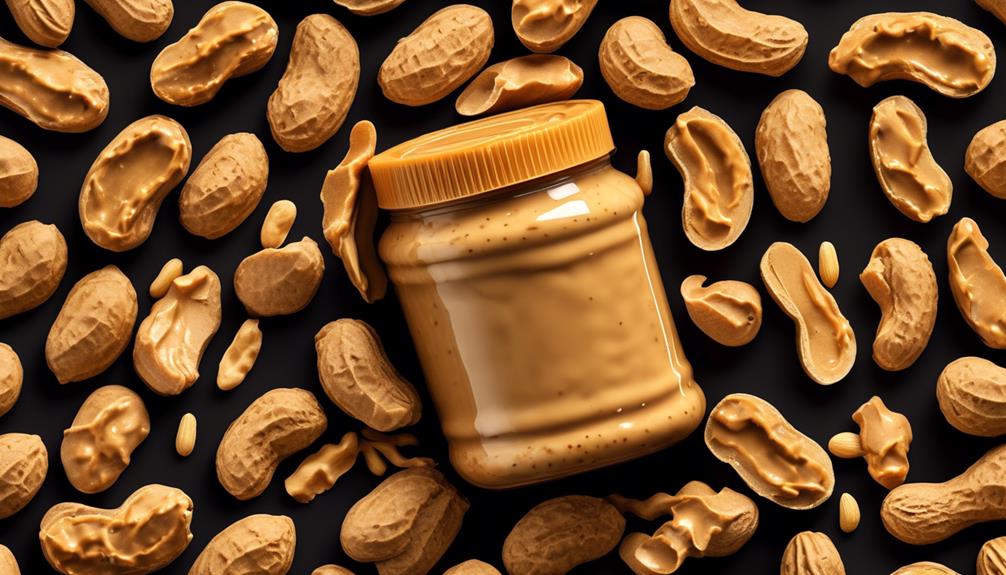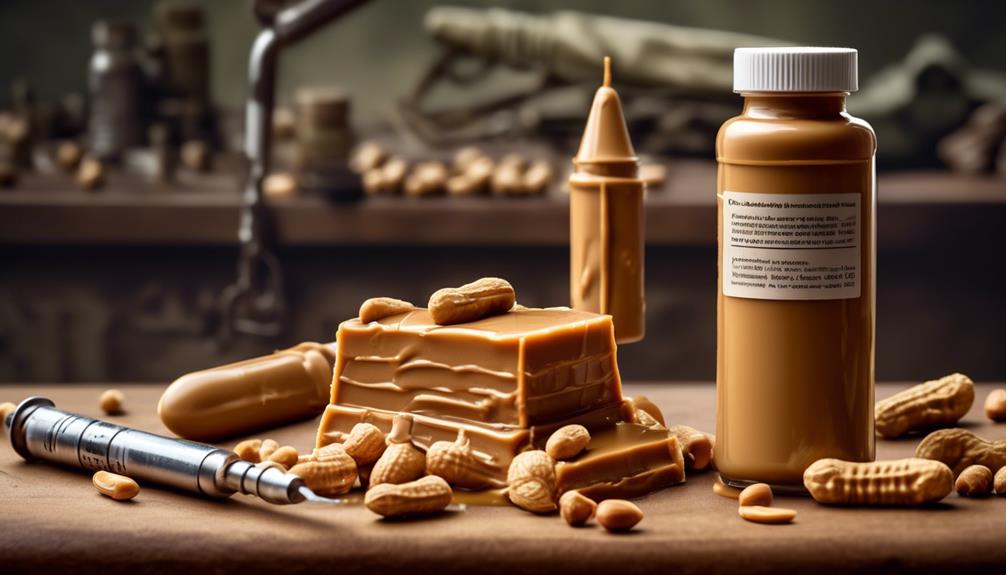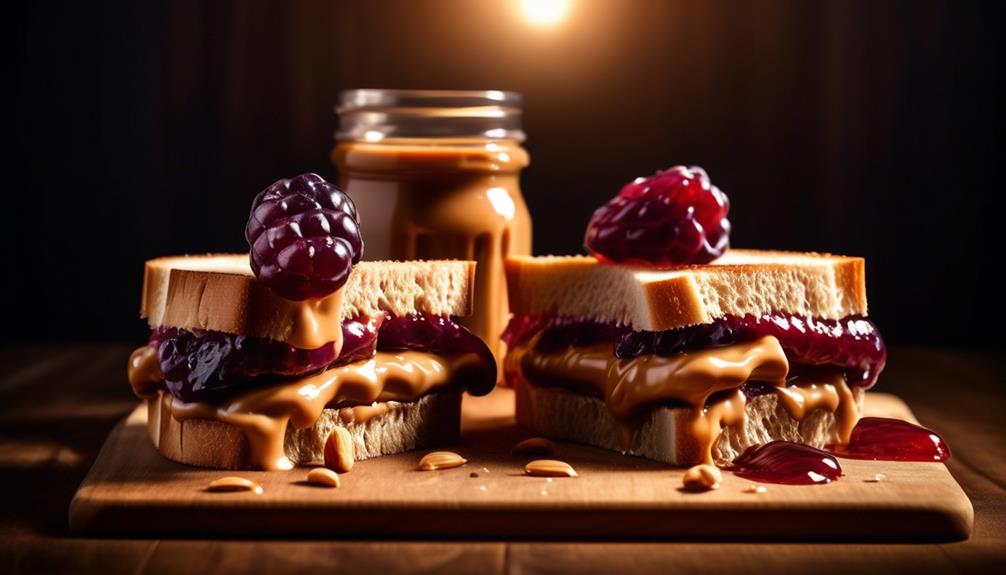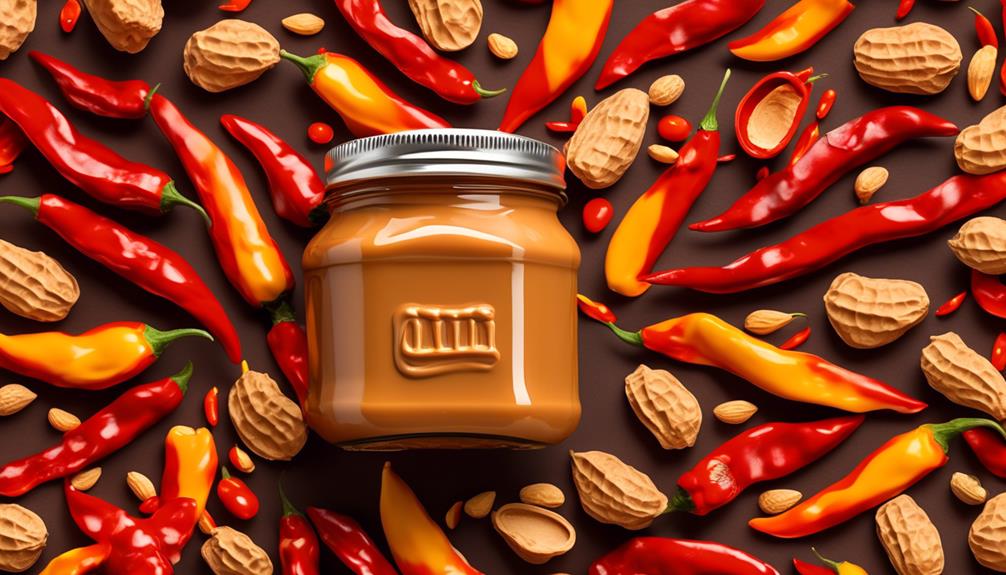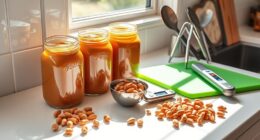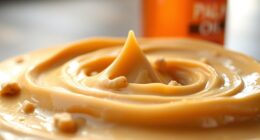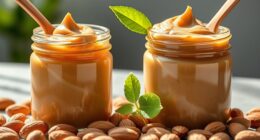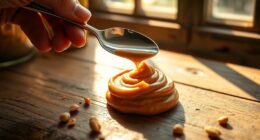Have you ever observed the small black specks in your jar of peanut butter and questioned their origin? It’s like discovering a hidden ingredient in a spread that is already tasty. While these specks may arouse our curiosity, rest assured they are nothing to be concerned about.
As we delve into the mystery of these specks, we'll uncover the fascinating world of peanut butter production and the various factors that contribute to the appearance of these specks.
So, what exactly are these black specks, and what do they tell us about the peanut butter we love? Let's explore.
Key Takeaways
- Roasting peanuts enhances flavor and reduces moisture, but over-roasting can result in the formation of dark spots in peanut butter.
- Black specks in peanut butter can originate from color variations in nuts, the dark inner skin of the nut, or trapped insects or beetles during processing.
- The presence of black specks or other contaminants in peanut butter does not necessarily indicate lower quality.
- The FDA allows a certain level of insect fragments and rodent hairs in peanut butter, as these contaminants can also be found in other foods.
Peanut Butter Production Process
As we roast the peanuts, we bring out their natural flavor and aroma while removing excess moisture. This step is crucial in the peanut butter production process as it significantly impacts the final product's taste and texture.
Once the peanuts have been roasted, they're then cooled before proceeding to the grinding stage. During grinding, the roasted peanuts are processed to form a smooth paste. It's important to note that the quality of the peanuts used directly affects the final product.
For instance, peanuts with higher fragments per 100 grams may result in a gritty texture in the peanut butter, while those with lower fragments per 100 grams produce a smoother consistency. Following the grinding process, additional ingredients such as salt, sugar, and oils may be blended into the peanut paste to create different variations of peanut butter, such as crunchy or creamy.
Peanut Harvesting and Processing

When harvesting peanuts, we uproot the entire plant and allow the peanuts to dry before collecting them for processing.
The process involves shelling and cleaning the peanuts to remove foreign matter, then roasting them to enhance flavor and reduce excess moisture.
Quality control measures are implemented throughout the processing techniques to ensure the smooth texture of the peanut butter and minimize the presence of dark specks.
Peanut Harvesting Process
Upon being uprooted from the ground, peanuts are left to dry in the field for several days as part of the harvesting process before being combined and processed.
This drying period is crucial as it allows the peanuts to reach the optimal moisture content for further processing.
Once dried, the peanuts undergo cleaning to remove any remaining dirt and foreign materials.
Subsequently, they're mechanically shelled to separate the kernels from the shells.
The kernels are then graded according to size and quality before undergoing the roasting process, which enhances their flavor and oil content.
The roasted peanuts are then cooled and ground into a paste to create peanut butter, which may contain small dark specks due to natural variations in the nuts.
Processing Techniques
After uprooting the entire peanut plant, the harvested peanuts undergo a drying process in the field before being cleaned, shelled, and processed using techniques such as blanching, roasting, and grinding to create peanut butter.
Blanching: Peanuts are briefly exposed to high temperatures then rapidly cooled to remove the skins, enhancing the smooth texture of the peanut butter.
Roasting: This process not only enhances the flavor and aroma of the peanuts but also removes excess moisture, ensuring a longer shelf life for the peanut butter.
Grinding: The roasted peanuts are ground into a fine paste, creating the creamy consistency of peanut butter while ensuring the uniform distribution of peanut particles, typically below the regulated level of insect fragments per ounce.
These processing techniques are crucial to producing high-quality peanut butter, balancing flavor, texture, and safety standards.
Quality Control Measures
Our quality control measures in peanut harvesting and processing rigorously ensure the absence of foreign material such as insects, rodent hairs, or mold in the final product. To achieve this, we implement meticulous inspection and sorting processes, minimizing the risk of trapped insects, beetles, or other foreign particles. Our processing facilities maintain strict cleanliness standards to prevent contamination, ensuring that the peanuts meet the highest quality standards. Additionally, we monitor and regulate the conditions during roasting and processing to minimize the occurrence of dark specks, guaranteeing the overall quality of the peanut butter. This unwavering commitment to quality control measures ensures that our products and services consistently deliver the excellence expected, providing consumers with the confidence to indulge in a delectable peanut butter sandwich.
| Quality Control Measures | Peanut Harvesting and Processing | Final Product |
|---|---|---|
| Meticulous Inspection | Carefully Sorted Peanuts | High Quality |
| Strict Cleanliness | Controlled Roasting Conditions | Confidence |
| Monitoring & Regulation | Minimized Presence of Dark Specks | Excellence |
Groundnut Quality Control

In groundnut quality control, meticulous scrutiny is applied to assess color variations and the presence of dark specks in the nuts. This process ensures that the final product meets high standards and is free from any defects that could compromise its quality and safety.
To achieve this, several measures are taken:
- Monitoring for Color Variations: The quality control team closely monitors the color of the groundnuts to identify any variations that could indicate issues with the roasting process or the presence of foreign matter.
- Assessing Dark Specks: Dark specks are carefully examined to determine their nature and origin, ensuring that they don't compromise the overall quality of the groundnuts.
- Trapped Insects or Beetles: Quality control also involves assessing the nuts for the presence of trapped insects or beetles from processing, ensuring that the final product is free from any contaminants.
These rigorous quality control measures play a crucial role in maintaining the integrity of groundnut products, including peanut butter, and providing consumers with a consistently high-quality and safe end product.
Fungal Growth in Peanuts

Groundnut quality control protocols, particularly the scrutiny for dark specks and contaminants, directly relates to the critical issue of fungal growth in peanuts, which can lead to the presence of black specks in peanut butter.
Fungal growth in peanuts, specifically the presence of Aspergillus flavus and Aspergillus parasiticus, poses a significant concern due to their production of aflatoxins. These toxins are carcinogenic and can be harmful if consumed in high levels. Therefore, proper storage and processing of peanuts are crucial for reducing the risk of aflatoxin contamination.
Regulatory bodies like the FDA monitor and regulate the presence of aflatoxins in peanuts to ensure consumer safety.
To prevent fungal growth and aflatoxin production, peanuts must be stored in dry conditions and at appropriate temperatures. Furthermore, careful monitoring of moisture levels during growth, harvesting, and storage is essential.
Additionally, thorough cleaning and inspection of peanuts before processing are necessary to remove any contaminated or mold-infested nuts. These measures are vital in ensuring the safety and quality of peanuts and ultimately minimizing the occurrence of black specks in peanut butter.
Aflatoxin Contamination

Unfortunately, aflatoxin contamination poses a significant health risk and can result in the presence of black specks in peanut butter. Aflatoxin, a toxic substance produced by molds such as Aspergillus flavus and Aspergillus parasiticus, is a known carcinogen and can lead to liver damage. Aflatoxin contamination is more prevalent in warm and humid climates and can occur during the growth, storage, and processing of peanuts. To mitigate aflatoxin levels, peanuts undergo rigorous monitoring and processing, and the USDA establishes limits for aflatoxin levels in peanut products.
Aflatoxin is a potent carcinogen, leading to an increased risk of liver cancer.
Warm and humid climates create favorable conditions for Aspergillus molds, increasing the likelihood of aflatoxin contamination.
Strict monitoring and processing of peanuts are essential to minimize aflatoxin levels, ensuring the safety of peanut products.
Addressing aflatoxin contamination is crucial to safeguard the quality and safety of peanut butter, as it directly impacts consumer health. Therefore, stringent measures and continuous monitoring are imperative to mitigate the risks associated with aflatoxin contamination in peanut butter.
Microscopic Examination of Peanut Butter

Upon microscopic examination, the presence of color variations, insect fragments, and rodent hairs in peanut butter can be identified within FDA limits.
Color variations in peanuts can give rise to dark specks, while insect fragments and rodent hairs may also be present, albeit in quantities deemed safe for consumption.
The FDA allows an average of 30 insect fragments and one or more rodent hairs per 100 grams of peanut butter. Microscopic examination, used to provide a close-up view of the peanut butter, can reveal the presence of these elements.
It's important to note that the presence of these contaminants doesn't necessarily reflect poor quality, as they're considered natural and unavoidable in food production processes. As such, the microscopic examination of peanut butter is a critical tool in ensuring that the product meets safety standards.
This analysis, which our website uses to inform consumers, offers an intimate look at the composition of peanut butter, reassuring individuals about the safety and quality of the product they consume.
Black Specks in Peanut Butter

After examining the microscopic composition of peanut butter, it's essential to address the issue of black specks present in the product, as they can originate from color variations in the nuts or the processing of peanuts. The presence of these dark specks can be attributed to several factors, including the following:
- Color Variations in Nuts: The dark inner skin of the nut or variations in the color of the peanuts themselves can contribute to the appearance of black specks in peanut butter.
- Processing Factors: Trapped insects or beetles from the processing of peanuts, as well as over-roasting, can lead to the presence of dark specks in the final product.
- Regulatory Standards: It's important to note that the presence of black specks doesn't necessarily indicate lower quality of the peanut butter. The FDA allows a certain level of insect fragments and rodent hairs in peanut butter, which is a regulatory standard for the food industry.
Considering these factors, it becomes evident that the presence of black specks in peanut butter is a result of various natural and processing-related elements, and it doesn't necessarily compromise the safety or quality of the product.
Identifying Foreign Particles

Identifying foreign particles in peanut butter requires careful examination of the product's composition and processing to determine the source of any dark specks present. It's essential to understand the potential sources of these specks to ensure the safety and quality of the peanut butter. The table below outlines the various factors that could contribute to the presence of dark specks in peanut butter.
| Potential Sources of Dark Specks in Peanut Butter | Description |
|---|---|
| Color variations in nuts | Dark specks may be caused by natural variations in the color of peanuts used in the butter. |
| Dark inner skin of the nut | The presence of the dark inner skin of peanuts can contribute to the appearance of dark specks in the butter. |
| Trapped insects or beetles | During processing, it's possible for insects or beetles to become trapped in the peanut butter, leading to dark specks. |
| Over-roasting peanuts | Over-roasting peanuts can result in the formation of dark spots, which may appear as specks in the peanut butter. |
Common Peanut Butter Contaminants

Common peanut butter contaminants include foreign particles such as insect fragments and rodent hairs, which are regulated by the FDA for allowable levels in the product. These contaminants are inevitable in food processing but are strictly monitored to ensure consumer safety.
- Insect Fragments: The FDA allows an average of 30 insect fragments per 100 grams of peanut butter. These fragments can come from pests that infiltrate the peanut crops or from the processing facilities.
- Rodent Hairs: Similarly, the FDA permits one or more rodent hairs per 100 grams of peanut butter. This is a result of rodents having access to the peanut storage or processing areas.
- Presence in Other Foods: It's important to note that insect fragments and rodent hairs aren't unique to peanut butter. They can also be found in other foods such as oregano, canned peaches, nuts, and olives due to the nature of food processing and storage.
While the thought of consuming these contaminants may be off-putting, it's crucial to understand that the FDA's regulations aim to keep these levels within safe limits and that the presence of these contaminants doesn't necessarily indicate a lower quality product.
Safe Consumption of Peanut Butter

Before diving into the points of safe consumption of peanut butter, it's crucial to consider allergen labeling requirements.
Storage and shelf life is another important factor to keep in mind. Proper storage can help maintain the quality and safety of peanut butter. It's recommended to store peanut butter in a cool, dry place, away from direct sunlight or heat sources. Additionally, it's important to check the expiration date and use the peanut butter before it expires.
Proper handling tips are also essential for safe consumption. It's important to always use clean utensils when scooping out peanut butter to prevent cross-contamination. Additionally, it's recommended to avoid double-dipping or using the same utensil for spreading after it has touched other foods. This can help prevent the spread of bacteria.
Understanding these aspects will help us make informed decisions and minimize potential risks associated with peanut butter consumption.
Allergen Labeling Requirements
We ensure the safe consumption of peanut butter through stringent allergen labeling requirements, which are mandated by law to clearly identify the presence of peanuts on packaging. This ensures individuals with peanut allergies can make informed choices and avoid potential allergic reactions.
The allergen labeling on peanut butter packaging plays a crucial role in helping consumers navigate food products and select safe options. By providing clear and accurate information about the presence of peanuts, individuals with peanut allergies can confidently enjoy peanut butter without compromising their health and well-being.
These labeling requirements are essential for promoting a safe and inclusive food environment, where all consumers can confidently choose products that align with their dietary needs and restrictions.
Storage and Shelf Life
Ensuring the safe consumption of peanut butter through stringent allergen labeling requirements, we now turn our focus to the crucial aspects of storage and shelf life, vital for maintaining the quality and safety of this popular food product. Proper storage and handling are essential to prevent spoilage and maintain freshness. Here are key guidelines for storing peanut butter:
| Storage | Shelf Life |
|---|---|
| Cool, dry place away from sunlight | Up to 3 months at room temperature, or up to 6 months in the refrigerator |
| Check expiration date | Discard if expired to avoid health risks |
| Seal tightly after use | Prevents spoilage and maintains freshness |
| Avoid cross-contamination | Use clean utensils to maintain quality |
Following these storage practices can help ensure the safe consumption and enjoyment of peanut butter.
Proper Handling Tips
To ensure the safe consumption of peanut butter, it's important to follow proper handling tips to prevent contamination and maintain product quality. When dealing with peanut butter, it's crucial to:
- Always use clean utensils to scoop out the desired amount, and avoid double-dipping to prevent cross-contamination.
- Keep the lid tightly sealed when not in use to prevent moisture and air from affecting the product's quality.
- Store peanut butter in a cool, dry place away from direct sunlight to maintain its freshness and prevent spoilage.
Following these handling tips will help ensure the safety and quality of your peanut butter, allowing you to enjoy its delicious taste without any concerns.
Quality Assurance in Food Production

Throughout the food production process, Quality Assurance ensures the adherence to standards and specifications, encompassing rigorous monitoring and control of various factors. This involves meticulous oversight of ingredient quality, production equipment, and hygiene practices to prevent defects, inconsistencies, and contamination in food products.
By implementing measures such as regular testing, inspections, and documentation, we maintain product integrity and compliance with regulations, ensuring consumer safety and satisfaction.
Additionally, Quality Assurance focuses on continuous improvement, risk management, and adherence to industry best practices to uphold the reputation and trust of the brand. Our commitment to Quality Assurance not only safeguards the quality and safety of our products but also demonstrates our dedication to delivering excellence.
We strive to exceed expectations by consistently meeting and surpassing industry standards, ensuring that every product that reaches our consumers is of the highest quality. Our rigorous approach to Quality Assurance is fundamental to our commitment to producing safe, reliable, and exceptional food products.
Regulatory Standards for Peanut Butter

In our commitment to maintaining product integrity and compliance with regulations, we now turn our focus to the regulatory standards for peanut butter, specifically addressing the permissible limits for insect fragments and rodent hairs set by the FDA.
- The FDA allows an average of 30 insect fragments per 100 grams of peanut butter.
- There may be an average of one or more rodent hairs per 100 grams of peanut butter, within the permissible limits.
- Both natural and non-natural peanut butter are subject to FDA regulations, with specific ingredient allowances and quality standards.
These standards and regulations are crucial in ensuring the safety and quality of peanut butter. The presence of insect fragments and rodent hairs in peanut butter is regulated and monitored by the FDA to prevent contamination and ensure consumer safety.
It's important to note that these standards apply not only to peanut butter but to various other food products as well. Adhering to these regulations is essential for manufacturers to uphold the quality and safety of their products, and for consumers to have confidence in the foods they consume.
Nutritional Value of Peanut Butter

As we delve into the nutritional value of peanut butter, it becomes evident that it is a multifaceted source of essential nutrients and beneficial compounds. Peanut butter is a rich source of protein, healthy fats, and vital nutrients such as vitamin E and magnesium. It also contains antioxidants like p-coumaric acid, which can contribute to reducing the risk of chronic diseases. The spread's high dietary fiber content aids in digestion and weight management. Additionally, peanut butter is a good source of potassium, essential for maintaining healthy blood pressure. Its versatility allows for inclusion in various recipes and enjoyment in different ways.
| Nutrient | Amount per 2 tbsp (32g) | % Daily Value |
|---|---|---|
| Protein | 8g | 16% |
| Fat | 16g | 25% |
| Vitamin E | 2.9mg | 15% |
| Magnesium | 49.8mg | 12% |
| Potassium | 208mg | 6% |
The nutritional content of peanut butter showcases its significant value as a source of essential nutrients. It's clear that incorporating peanut butter into one's diet can contribute to overall health and well-being.
Minimizing Peanut Butter Spoilage

We can extend the shelf life of peanut butter by taking steps to preserve its freshness. Storing it in a cool, dry place and using clean utensils to prevent contamination are crucial.
Additionally, regularly checking for signs of mold or unusual odors and consuming the peanut butter within a reasonable time frame will help ensure its freshness.
Preserving Freshness
To minimize peanut butter spoilage and maintain freshness, proper storage in a cool, dry place is essential. Keeping the lid tightly closed after each use can prevent moisture and air from entering the jar, which helps maintain freshness. Avoiding double-dipping with contaminated utensils can prevent the introduction of bacteria and prolong the shelf life of peanut butter.
Refrigerating natural peanut butter can slow down the oil separation process and extend its freshness. Choosing peanut butter without added preservatives and stabilizers can ensure a shorter ingredient list and potentially reduce the risk of spoilage.
These practices are crucial in preserving the quality of peanut butter and ensuring its shelf life.
Extending Shelf Life
Storing peanut butter in a cool, dry place is essential for minimizing spoilage and extending its shelf life. Refrigeration can further prolong its freshness and prevent rancidity. It's crucial to store peanut butter in an airtight container to shield it from exposure to air and moisture, both of which can accelerate spoilage.
Additionally, using clean utensils when handling peanut butter is imperative to prevent contamination and spoilage. Regularly inspecting the peanut butter for any changes in color, texture, or smell is vital before consumption to ensure its quality.
Frequently Asked Questions
What Are the Specks in Peanut Butter?
We often notice dark specks in peanut butter. These can be due to color variations in the nuts or the dark inner skin of the nut.
Sometimes, they might be trapped insects or occur from over-roasting peanuts. However, their presence doesn't necessarily mean lower quality.
The FDA allows a certain amount of insect fragments in peanut butter, and consuming these is considered safe.
What Are the Black Dots in Peanuts?
The black dots in peanuts are often just color variations or small particles of the peanut's inner skin. Sometimes, they can be remnants of insects or beetles from the processing stage. Over-roasting peanuts can also create these dark spots.
It's important to note that the presence of these dots doesn't necessarily indicate lower quality. Overall, understanding the origin of these specks can help reassure consumers about the quality of their peanut products.
What Are the Spots on the Top of Peanut Butter?
We notice the spots on the top of peanut butter, caused by color variations in the peanuts or the dark inner skin of the nut. It's essential to know that the presence of these spots doesn't necessarily indicate lower quality.
Over-roasting peanuts can also lead to this.
Regardless, peanut butter is versatile and pairs well with various bread types, fruits like bananas and apples, and flavor additions like honey or chocolate chips for extra taste.
How Can You Tell if Peanut Butter Is Moldy?
We can tell if peanut butter is moldy by examining its appearance and smell.
Moldy peanut butter may have a fuzzy green or white growth on the surface and emit a musty or sour odor.
If the peanut butter has an off-putting smell or unusual texture, it's best to discard it.
Always check for signs of mold before consuming to ensure safety.
Conclusion
As we delve into the world of peanut butter production, we uncover the truth behind the black specks. Like the contrasting shades of black and white, these specks are simply a natural variation in the peanuts, not a sign of inferior quality.
Just as the dark specks blend seamlessly into the creamy peanut butter, so too should we embrace diversity and differences, recognizing the richness they bring to our lives.
